Basic Experimental Study of Plasticity Material for Coal Rock Fracture Grouting Based on RSM-PCA Technology
Abstract
:1. Introduction
2. Materials and Methods
2.1. Materials
2.2. Experimental Design
2.3. Experiment Procedures
2.4. Numerical
2.4.1. PCA of Basic Performance Indexes
2.4.2. Analysis of RSM
3. Results
3.1. Basic Performance of Grouting
3.1.1. Bleeding Rate and Setting Time
3.1.2. Viscosity
3.1.3. Unconfined Compressive Strength
3.2. PCA of Slurry Performance Index
3.3. RSM Analysis
3.4. Mixing Optimization and Verification
3.5. Microanalysis
3.5.1. Microstructure of Solidified Slurry
3.5.2. Phase Composition Analysis of Curing System
4. Conclusions
Author Contributions
Funding
Institutional Review Board Statement
Informed Consent Statement
Data Availability Statement
Acknowledgments
Conflicts of Interest
Abbreviations
| PCA | Principal Component Analysis |
| RSM | Response Surface Method |
| RSM-PCA | Combining of response surface method and principal component analysis |
| SEM | Scanning Electron Microscope |
| W/C | Water-Cement ratio |
| XRD | X-Ray Diffraction |
| C3A | Tricalcium Aluminate |
| C3S | Tricalcium Silicate |
| C4AF | Tetracalcium Aluminoferrite |
| C-S-H | Calcium Silicate Hydrate |
| KMO | Kaiser Meyer Olkin |
| C | The cumulative characteristic value |
| F | The comprehensive score |
| Fmax | The maximum value in the comprehensive score |
| Fmin | The minimum value in the comprehensive score. |
| Fi | The score of the main component |
| i | Index |
| Xi | The value of the influencing factors |
| Xj | The value of the influencing factors |
| Y | The response prediction value |
| Yi | The characteristic value of the main component |
| Z | A standardized comprehensive score |
| α0 | Constant |
| αi | A linear coefficient |
| αii | A square coefficient |
| αij | An interaction coefficient |
References
- Li, Y.; Zhao, Y.; Jiang, Y.; Zhang, B.; Song, H.; Liu, B. Characteristics of Pore and Fracture of Coal with Bursting Proneness Based on DIC and Fractal Theory. Energies 2020, 13, 5404. [Google Scholar] [CrossRef]
- Hu, X.; Xie, J.; Cai, W.C.; Wang, R.; Davarpanah, A. Thermodynamic effects of cycling carbon dioxide injectivity in shale reservoirs. J. Pet. Sci. Eng. 2020, 195, 107717. [Google Scholar] [CrossRef]
- Davarpanah, A.; Mirshekari, B. Experimental Investigation and Mathematical Modeling of Gas Diffusivity by Carbon Dioxide and Methane Kinetic Adsorption. Ind. Eng. Chem. Res. 2019, 58, 12392–12400. [Google Scholar] [CrossRef]
- Ma, D.; Li, Q.; Hall, M.; Wu, Y.S. Experimental Investigation of Stress Rate and Grain Size on Gas Seepage Characteristics of Granular Coal. Energies 2017, 10, 527. [Google Scholar] [CrossRef] [Green Version]
- Shimada, H.; Hamanaka, A.; Sasaoka, T.; Matsui, K. Behavior of grouting material used for floor reinforcement in underground mines. Int. J. Min. Reclam. Environ. 2013, 28, 133–148. [Google Scholar] [CrossRef]
- Sun, Y.T.; Li, G.C.; Basarir, H.; Karrech, A.; Reza Azadi, M. Laboratory evaluation of shear strength properties for cement-based grouted coal mass. Arab. J. Geosci. 2019, 12, 690. [Google Scholar] [CrossRef]
- Ma, S.H.; Ruben, S.; Li, X.R.; Shen, X.D.; Karen, L. Scrivener, Alite-ye’elimite clinker: Hydration kinetics, products and microstructure. Constr. Build. Mater. 2021, 266 Pt B, 121062. [Google Scholar] [CrossRef]
- Xu, R.; Zuo, Y.J. Properties of clay cement grout and mechanism of water control. J. China Coal Soc. 1996, 21, 613–617. [Google Scholar] [CrossRef]
- Song, Y.B.; Gao, Q.C. Mechanism of grouting for waterproof using organic material with high water content. J. Min. Saf. Eng. 2006, 23, 320–322. [Google Scholar]
- Liu, Y.; Chen, B. Research on the preparation and properties of a novel grouting material based on magnesium phosphate cement. Constr. Build. Mater. 2019, 214, 516–526. [Google Scholar] [CrossRef]
- Zhu, X.X.; Zhang, Q.; Zhang, W.Q.; Shao, J.L.; Wang, Z.Y.; Wu, X.T. Experimental Study on the Basic Properties of a Green New Coal Mine Grouting Reinforcement Material. ACS Omega 2020, 5, 16722–16732. [Google Scholar] [CrossRef]
- Duan, H.F.; Jiang, Z.Q.; Zhu, S.Y.; Pu, Y.; Sun, Q. New composite grouting materials: Modified urea–formaldehyde resin with cement. Int. J. Min. Sci. Technol. 2012, 22, 195–200. [Google Scholar] [CrossRef]
- Xu, G.Q.; Yan, J.P.; Xia, X.L. Optimization experiment on mixing ratio of new grouting material to prevent mine floor water inrush. Coal Sci. Technol. 2010, 38, 22–24. [Google Scholar]
- Zhang, J.; Li, S.C.; Li, Z.F.; Zhang, Q.S.; Yang, L.; Du, J.Q.; Li, H.T.; Qi, Y.H.; Lin, R.F. Grouting Effect on Reinforcement of Weathered Granite. Geotech. Geol. Eng. 2020, 38, 2873–2886. [Google Scholar] [CrossRef]
- Zhang, Z.Z.; Han, C.L.; Li, C.W. Application of response surface method in experimental design and optimization. J. Henan Inst. Educ. (Nat. Sci. Ed.) 2011, 20, 34–37. [Google Scholar] [CrossRef]
- Amiandamhen, S.; Meincken, M.; Tyhoda, L. Magnesium based phosphate cement binder for composite panels: A response surface methodology for optimisation of processing variables in boards produced from agricultural and wood processing industrial residues. Ind. Crops Prod. 2016, 94, 746–754. [Google Scholar] [CrossRef]
- Zhu, M.; Yu, L.; Zhang, X.; Davarpanah, A. Application of Implicit Pressure-Explicit Saturation Method to Predict Filtrated Mud Saturation Impact on the Hydrocarbon Reservoirs Formation Damage. Mathematics 2020, 8, 1057. [Google Scholar] [CrossRef]
- Li, T.; Yao, B.H.; Liu, Y.; Wang, D.K. Grouting Fractured Coal Permeability Evolution Based on Industrial CT Scanning. Geofluids 2021, 2021, 5564786. [Google Scholar] [CrossRef]
- Wang, X.H. Study of rheological properties of clay-cement pastes and the effect factors. Chin. J. Geotech. Eng. 1997, 19, 45–50. [Google Scholar]
- Dejaeghere, I.; Sonebi, M.D.; Schutter, G. Influence of nano-clay on rheology, fresh properties, heat of hydration and strength of cement-based mortars. Constr. Build. Mater. 2019, 222, 73–85. [Google Scholar] [CrossRef]
- Rahmani, E.; Sharbatdar, M.K.; Beygi, H.A. A comprehensive investigation into the effect of water to cement ratios and cement contents on the physical and mechanical properties of Roller Compacted Concrete Pavement (RCCP). Constr. Build. Mater. 2020, 253, 119177. [Google Scholar] [CrossRef]
- GB/T256-88. Determination of Kinematic Viscosity and Calculation of Dynamic Viscosity; Standardization Administration of the People’s Republic of China: Beijing, China, 2002. [Google Scholar]
- GB50204. Code for Acceptance of Construction Quality of Concrete Structure Engineering; Standardization Administration of the People’s Republic of China: Beijing, China, 2015. [Google Scholar]
- Lin, H.M.; Du, Z.F. Some problems in comprehensive evaluation in the principal component analysis. Stat. Res. 2013, 30, 25–31. [Google Scholar]
- Fan, X.L.; Feng, H.H.; Yuan, M. PCA based on mutual information for feature selection. Control Decis. 2013, 28, 915–919. [Google Scholar]
- Xiao, S.D.; Wang, J.; Xue, Y.X.; Zhang, H.L. Optimization of cactus fermented wine process by response surface-principal component analysis. Sci. Technol. Food Ind. 2019, 40, 113–119, 128. [Google Scholar]
- Zhang, C.; Yang, J.S.; Ou, X.F.; Fu, J.Y.; Xie, Y.P.; Liang, X. Clay dosage and water/cement ratio of clay-cement grout for optimal engineering performance. Appl. Clay Sci. 2018, 163, 312–318. [Google Scholar] [CrossRef]
- Nicoleau, L.; Nonat, A. A new view on the kinetics of tricalcium silicate hydration. Cem. Concr. Res. 2016, 86, 1–11. [Google Scholar] [CrossRef]
- Georgios, C.; Franz-Josef, U. The nanogranular nature of C-S-H. J. Mech. Phys. Solids 2007, 55, 64–90. [Google Scholar] [CrossRef]
- Pu, S.Y.; Zhu, Z.D.; Song, W.L.; Wan, Y.; Wang, H.R.; Song, S.G.; Zhang, J. Mechanical and Microscopic Properties of Cement Stabilized Silt. KSCE J. Civ. Eng. 2020, 24, 2333–2344. [Google Scholar] [CrossRef]
- Liu, F.; Zheng, M.; Ye, Y. Formulation and properties of a newly developed powder geopolymer grouting material. Constr. Build. Mater. 2020, 258, 120304. [Google Scholar] [CrossRef]
- Liu, J.; Zhang, G.J.; Yang, D.S.; Zhong, P. Rheological properties of clay-cement grouting material and influence on grouting. Bull. Chin. Ceram. Soc. 2016, 35, 2581–2589. [Google Scholar]
- Xie, K.H.; Xia, C.Q.; An, R.; Hu, A.F.; Zhang, W.P. A study on the one-dimensional consolidation of double-layered structured soils. Comput. Geotech. 2016, 73, 189–198. [Google Scholar] [CrossRef]
- Li, B. Investigation of the Mesco-Mechanical Properties of Calcium-Silicate-Hydrate. Ph.D. Thesis, Harbin Engineering University, Harbin, China, 2018. [Google Scholar]
- Habert, G.; Choupay, N.; Escadeillas, G.; Guillaume, D.; Montel, J.M. Clay content of argillites: Influence on cement based mortars. Appl. Clay Sci. 2008, 43, 322–330. [Google Scholar] [CrossRef]
- Horpibulsuk, S.K.; Rachan, R.L.; Chinkulkijniwat, A.; Raksachon, Y. Analysis of strength development in cement-stabilized silty clay from microstructural considerations. Constr. Build. Mater. 2010, 24, 2011–2021. [Google Scholar] [CrossRef]
- Sekkal, W.; Zaoui, A.; Benzerzour, M.; Abriak, N. Role of porosity on the stiffness and stability of (001) surface of the nanogranular C–S–H gel. Cem. Concr. Res. 2016, 114, 229–233. [Google Scholar] [CrossRef]
- Li, J.H.; Guo, Y.H. Principal component evaluation—A multivariate evaluate method expanded from principal component analysis. J. Ind. Eng. Manag. 2002, 16, 39–43. [Google Scholar]
- Durante, M.; Ferramosca, A.; Treppiccione, L.; Giacomo, M.; Zara, V.; Montefusco, A.; Piro, G.; Mita, G.; Bergamo, P.; Lenucci, M.S. Application of response surface methodology (RSM) for the optimization of supercritical CO2 extraction of oil from patè olive cake: Yield, content of bioactive molecules and biological effects in vivo. Food Chem. 2020, 332, 127405. [Google Scholar] [CrossRef] [PubMed]
- Yang, Y.S.; Shen, H.J.; Qiu, J. Bio-inspired self-bonding nanofibrillated cellulose composite: A response surface methodology for optimization of processing variables in binderless biomass materials produced from wheat-straw-lignocelluloses. Ind. Crop. Prod. 2020, 149, 112335. [Google Scholar] [CrossRef]
- Hamza, G. On the viscous behavior of cement mixtures with clay, sand, lime and bottom ash for jet grouting. Constr. Build. Mater. 2015, 93, 891–910. [Google Scholar] [CrossRef]
- Chang, S.; Xu, R.Q.; Li, X.G.; Wang, X.C. Optimization of formula for stabilizing muddy soil using response surface methodology. Rock Soil Mech. 2014, 35, 105–110. [Google Scholar]
- GB50164. Standard for Test Method of Performance on Building Morta; Standardization Administration of the People’s Republic of China: Beijing, China, 2011. [Google Scholar]
- Rodrigo, F.; Fernando, M.; Karen, L.S. The origin of the pozzolanic activity of calcined clay minerals: A comparison between kaolinite, illite and montmorillonite. Cem. Concr. Res. 2011, 41, 113–122. [Google Scholar] [CrossRef]
- Chen, S.; Xie, J.; Yang, Z. Effect of reactive montmorillonite with amino on the properties of polyimide/montmorillonite nanocomposite. Polym. Bull. 2020, 77, 687–699. [Google Scholar] [CrossRef]
- Wang, D.H.; Shi, C.J.; Farzadnia, N.; Shi, Z.G.; Jia, H.F.; Ou, Z.H. A review on use of limestone powder in cement-based materials: Mechanism, hydration and microstructures. Constr. Build. Mater. 2018, 181, 659–672. [Google Scholar] [CrossRef]
- Mori, K.; Fukunaga, T.; Sugiyama, M.; Iwase, K.; Oishi, K.; Osamu, Y. Hydration properties and compressive strength development of Low Heat Cement. J. Phys. Chem. Solids 2012, 73, 1274–1277. [Google Scholar] [CrossRef]
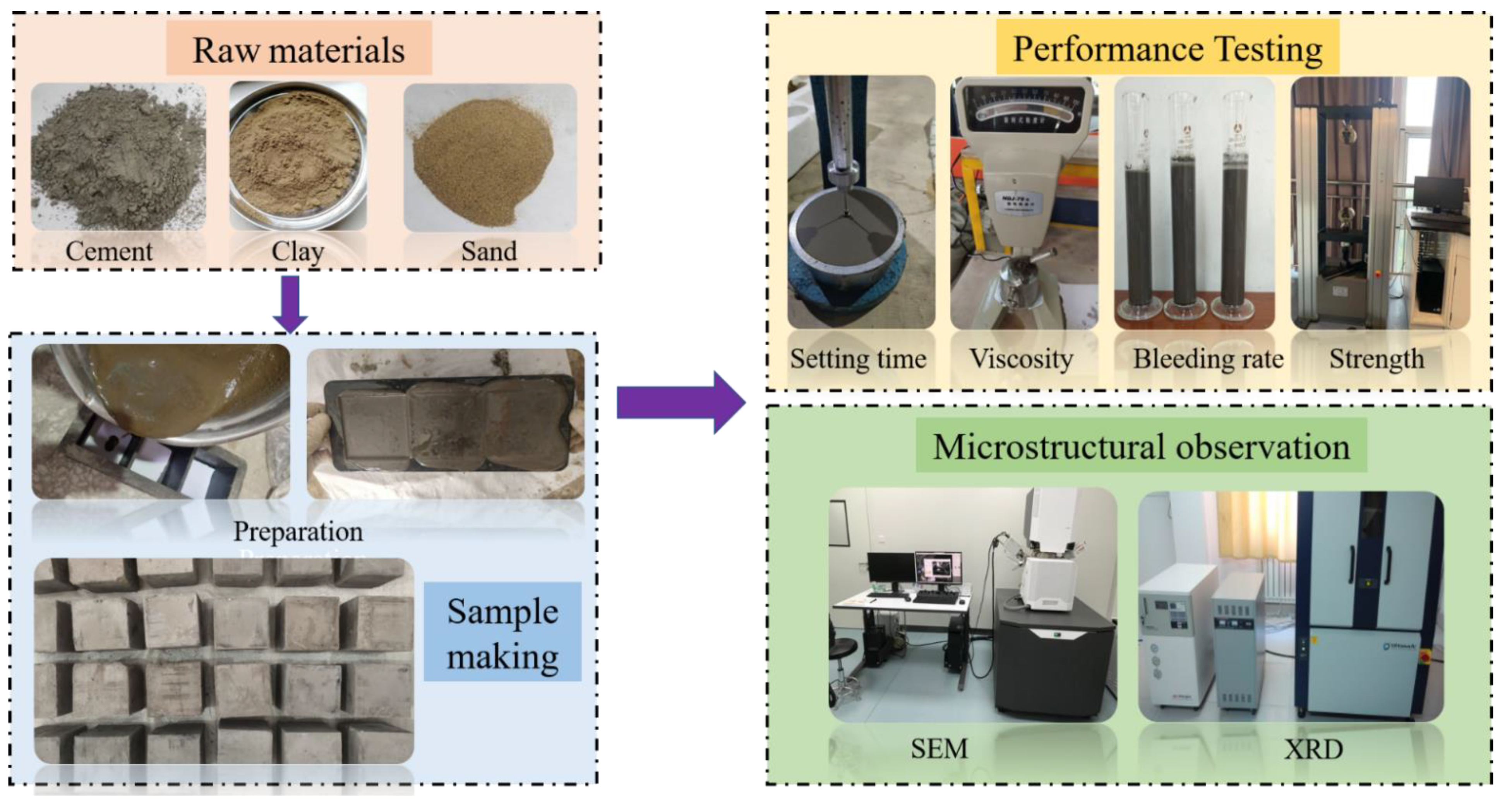
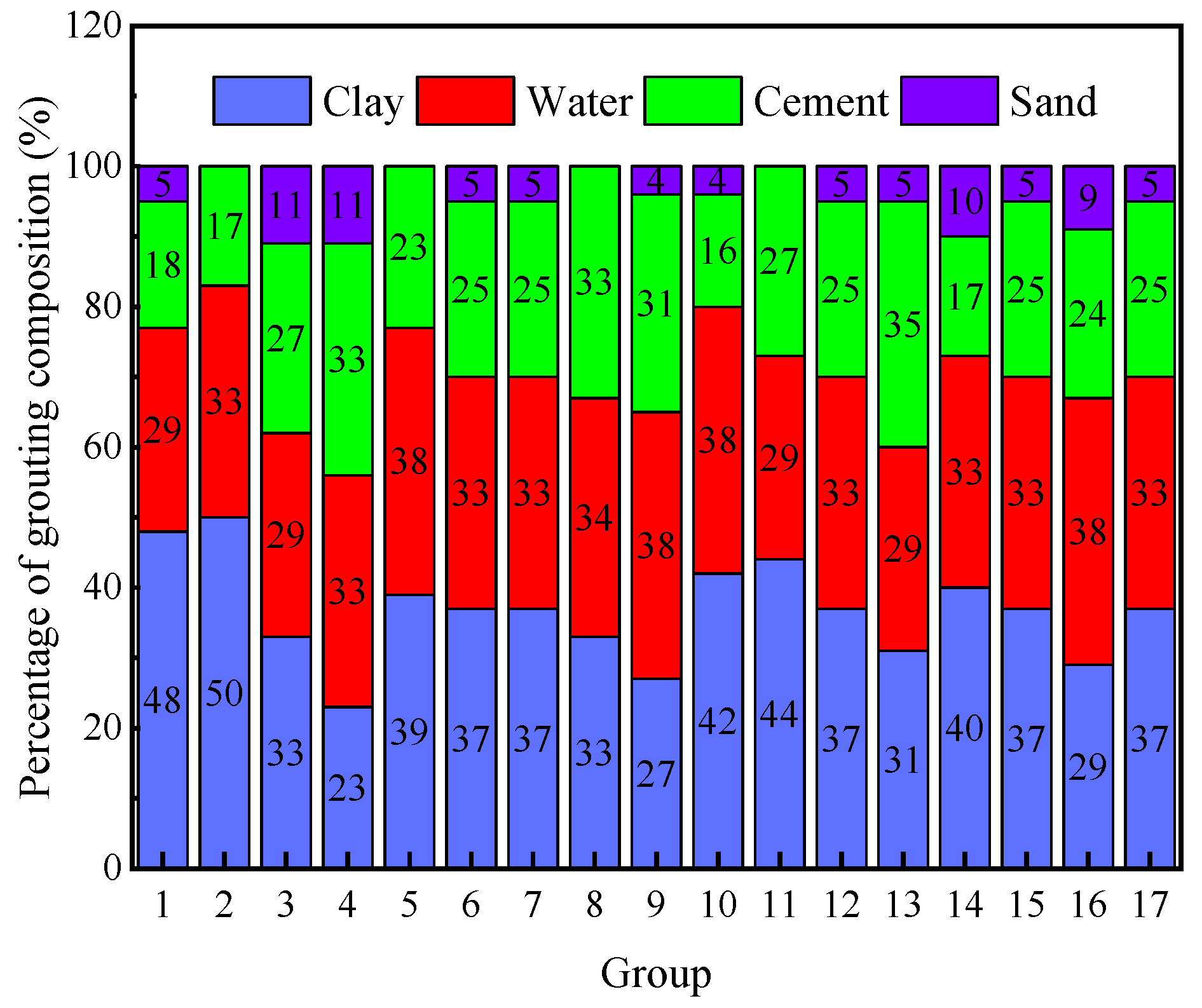
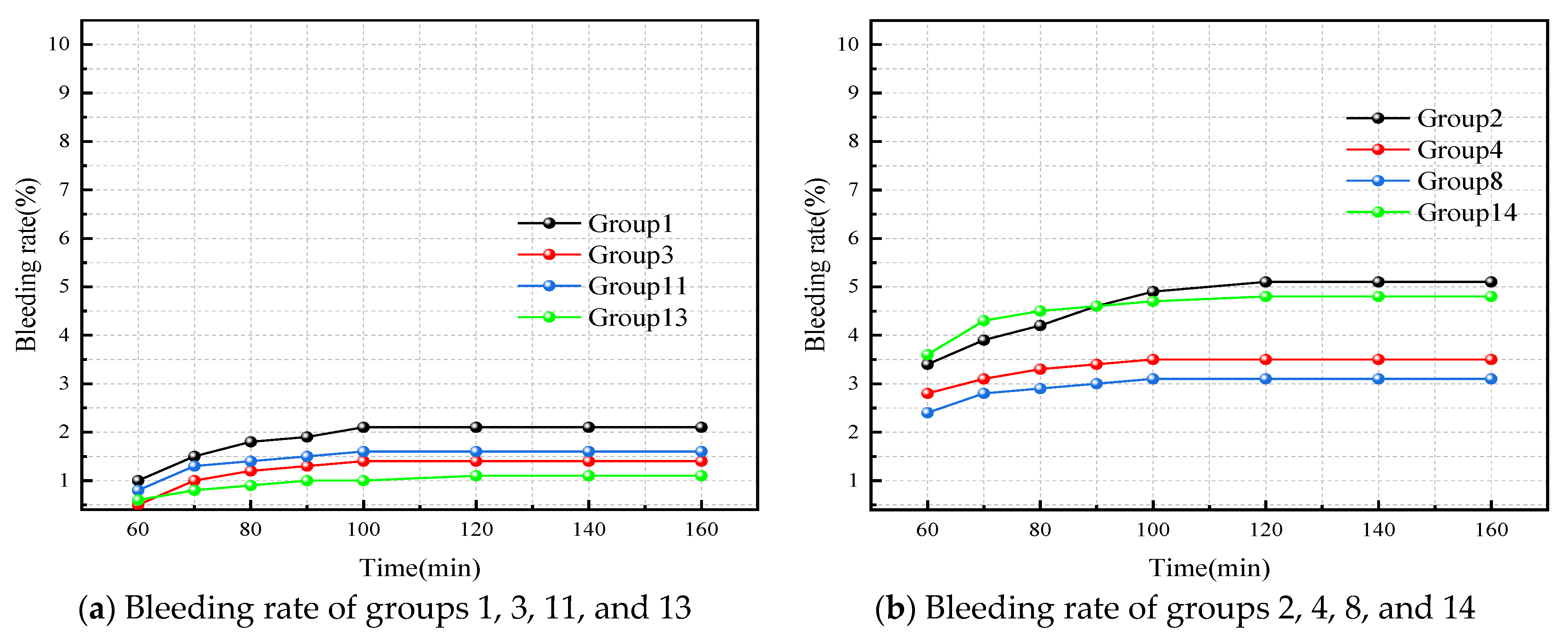


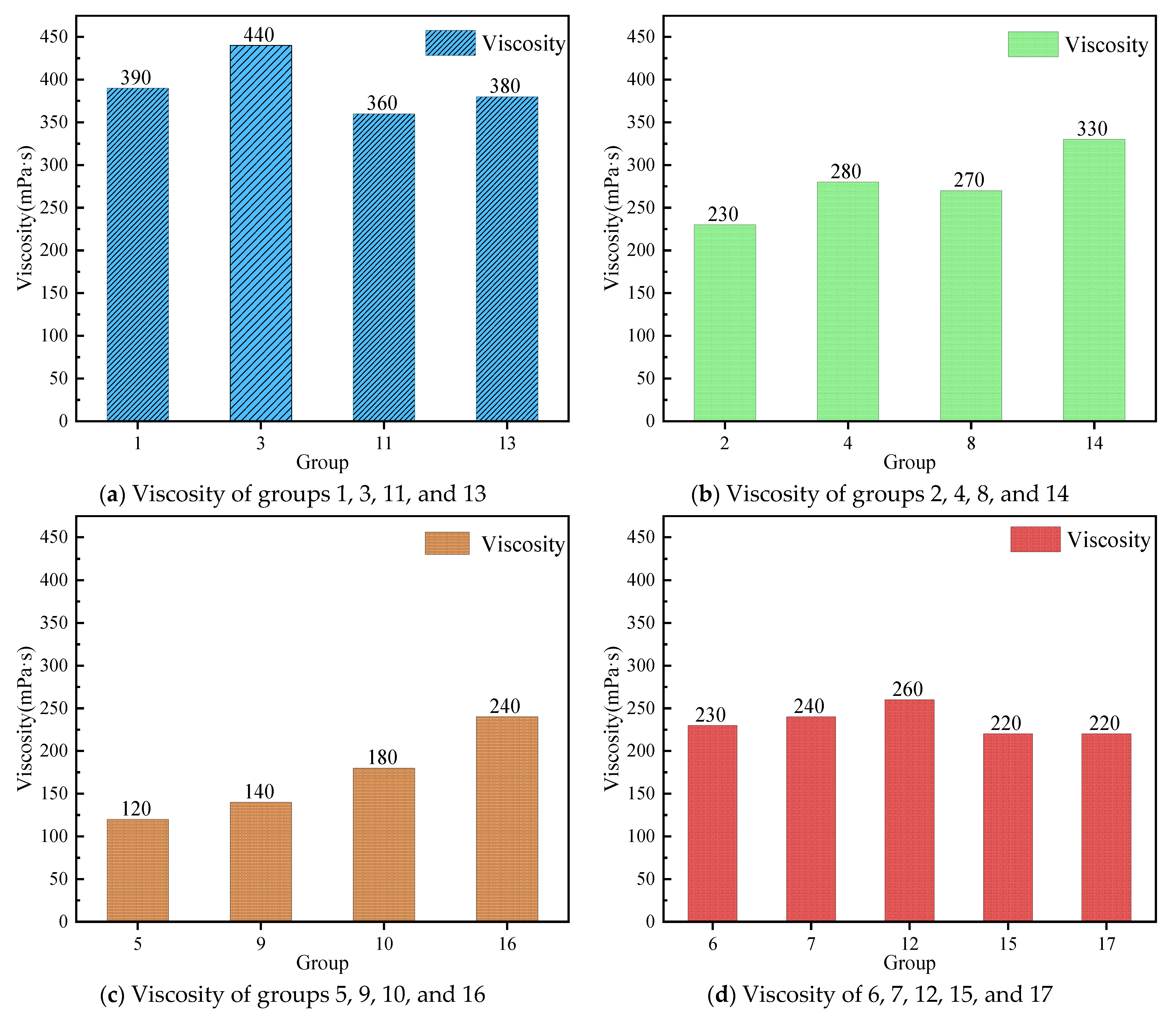
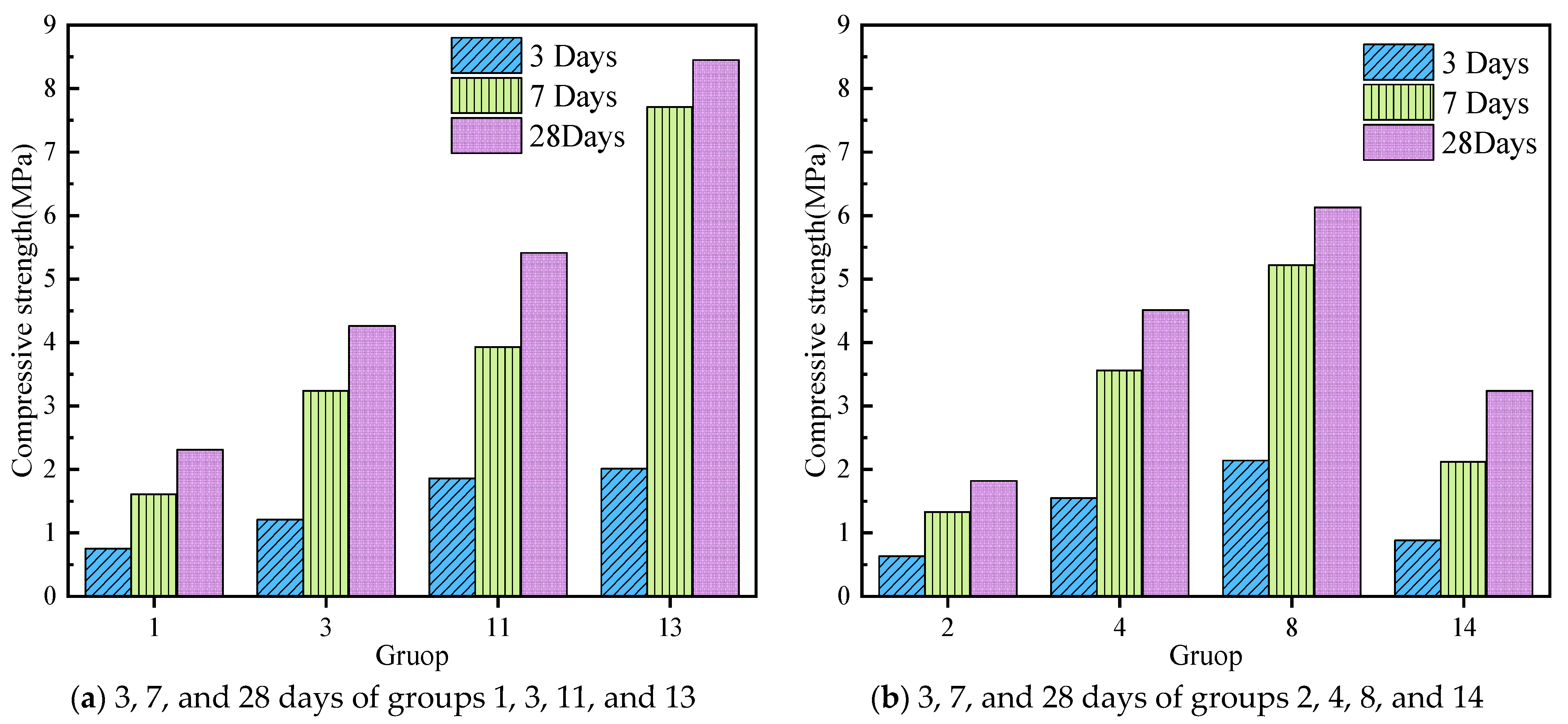
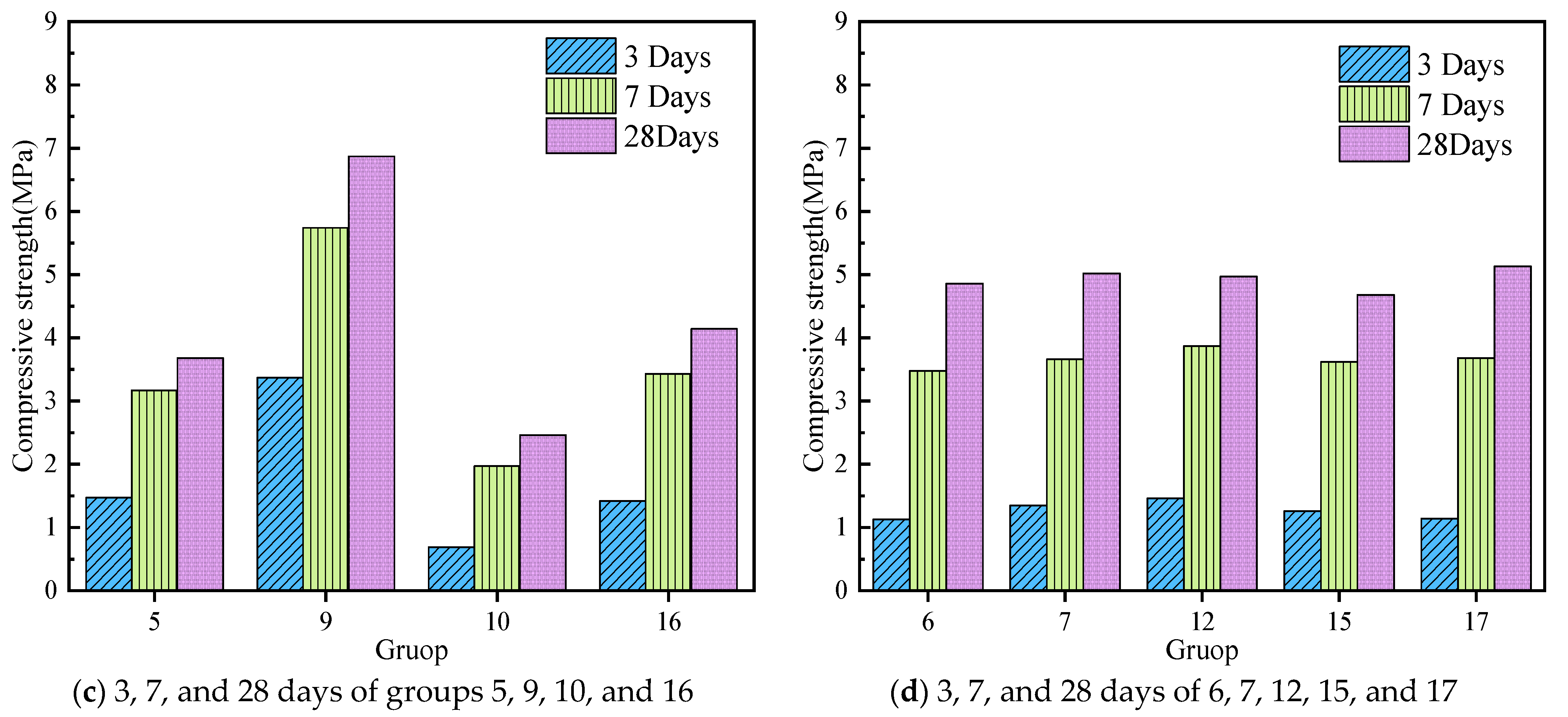
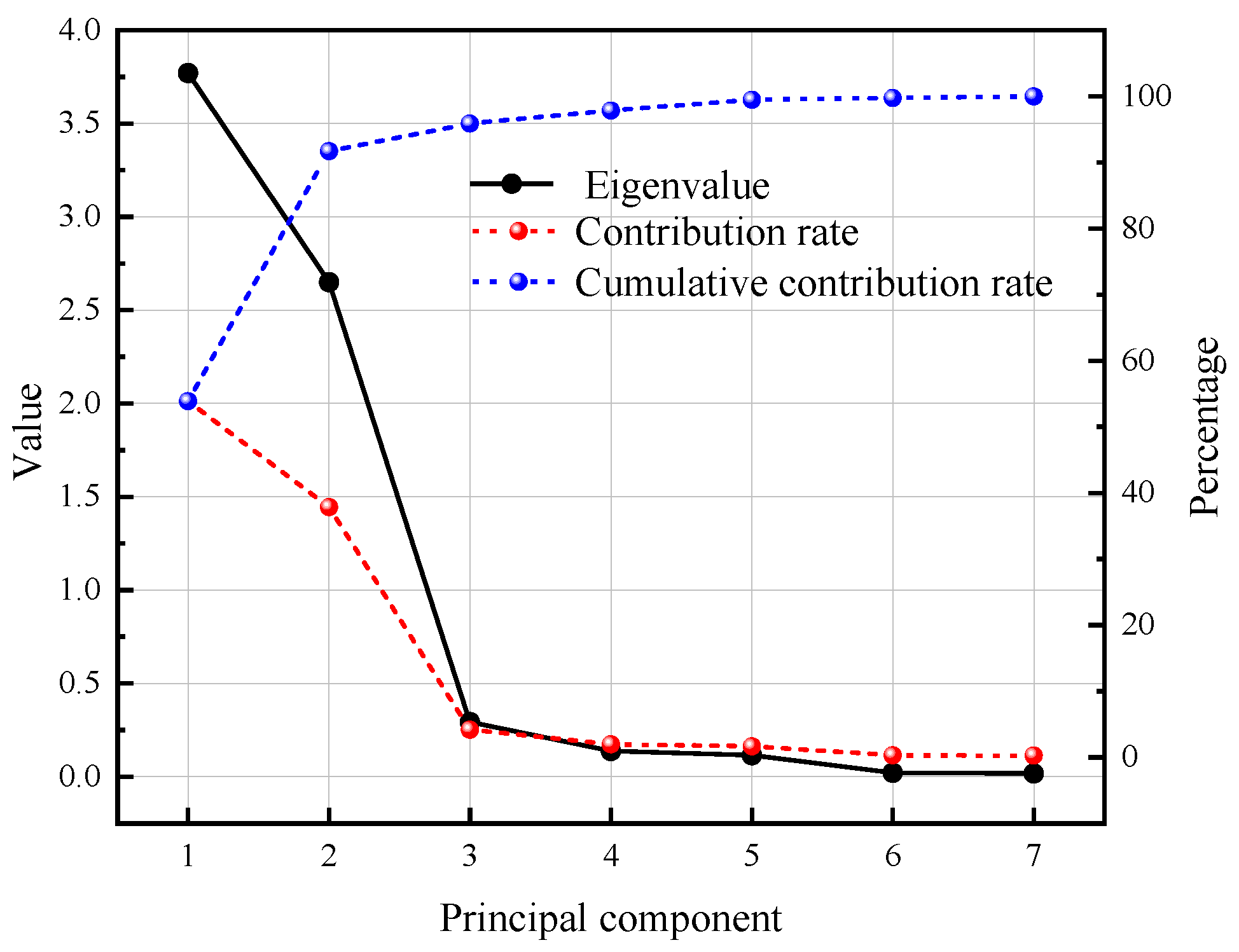
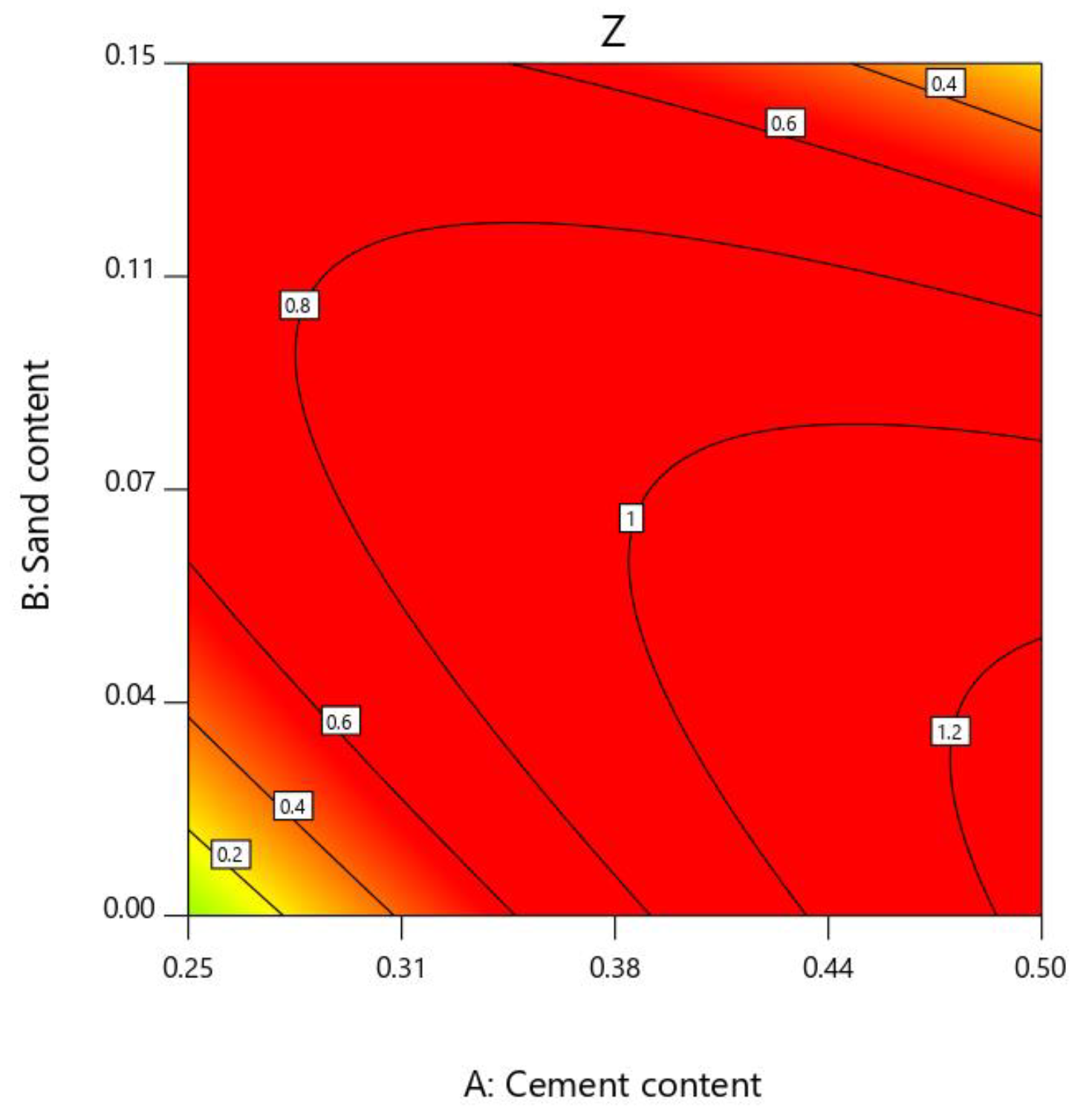
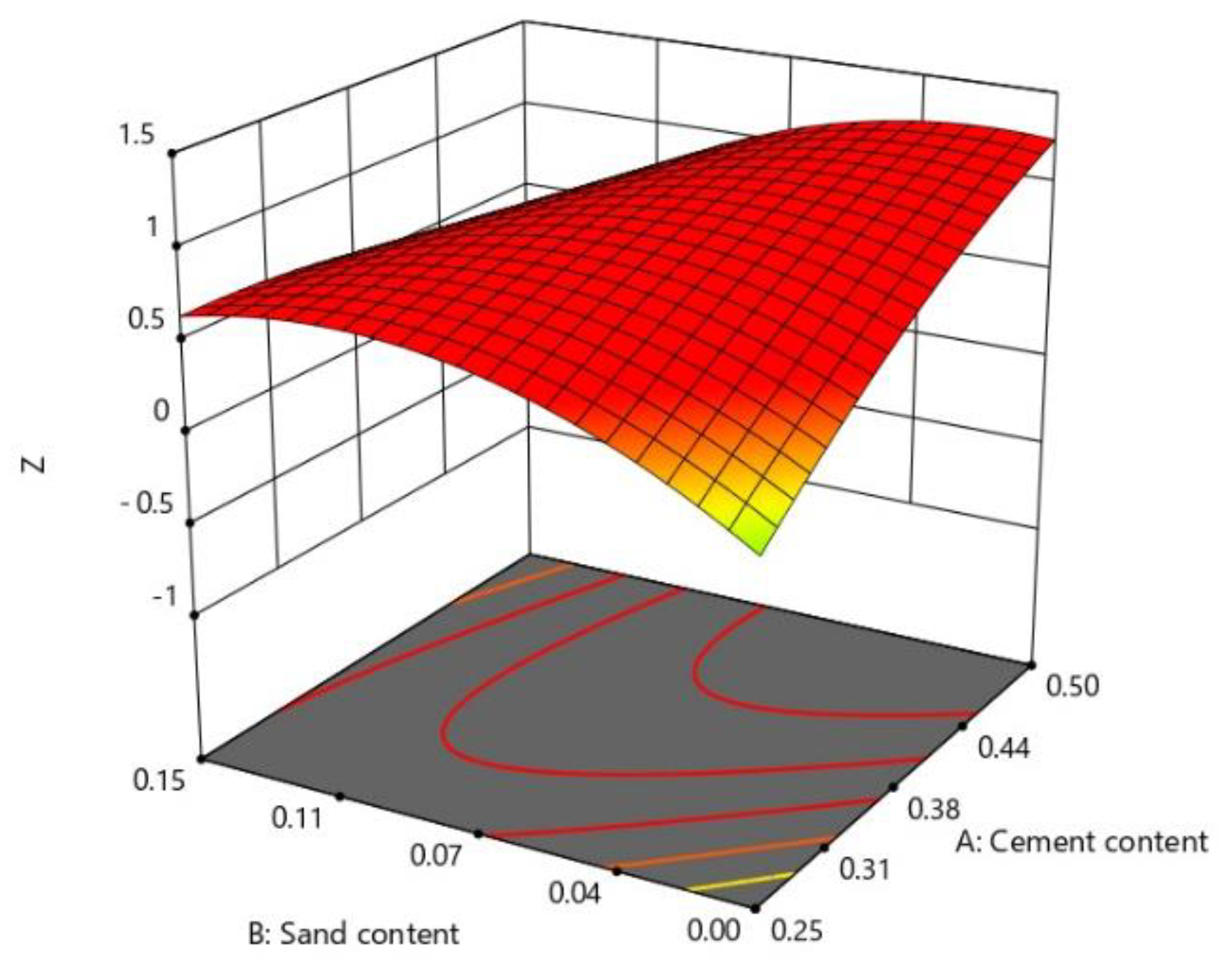
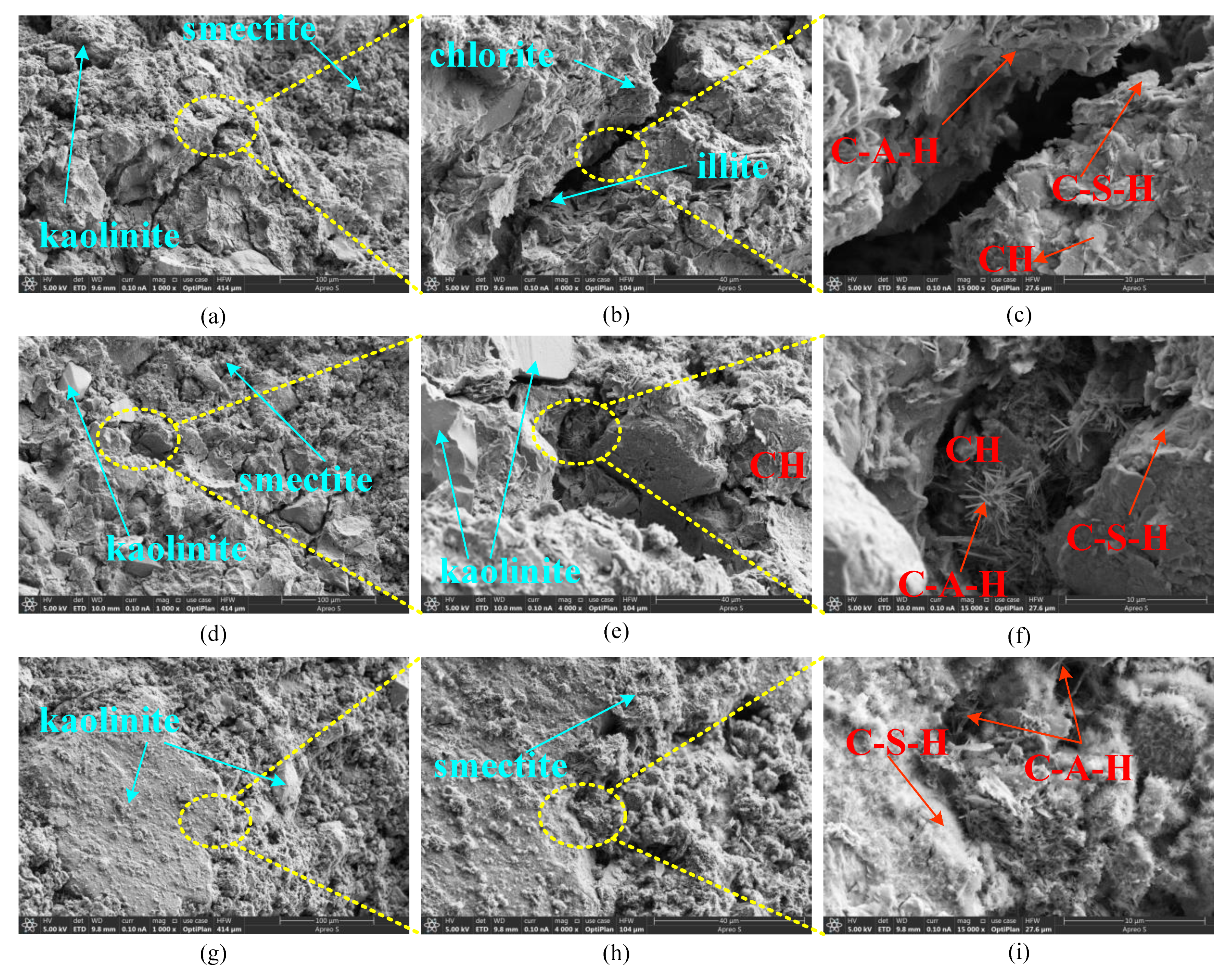
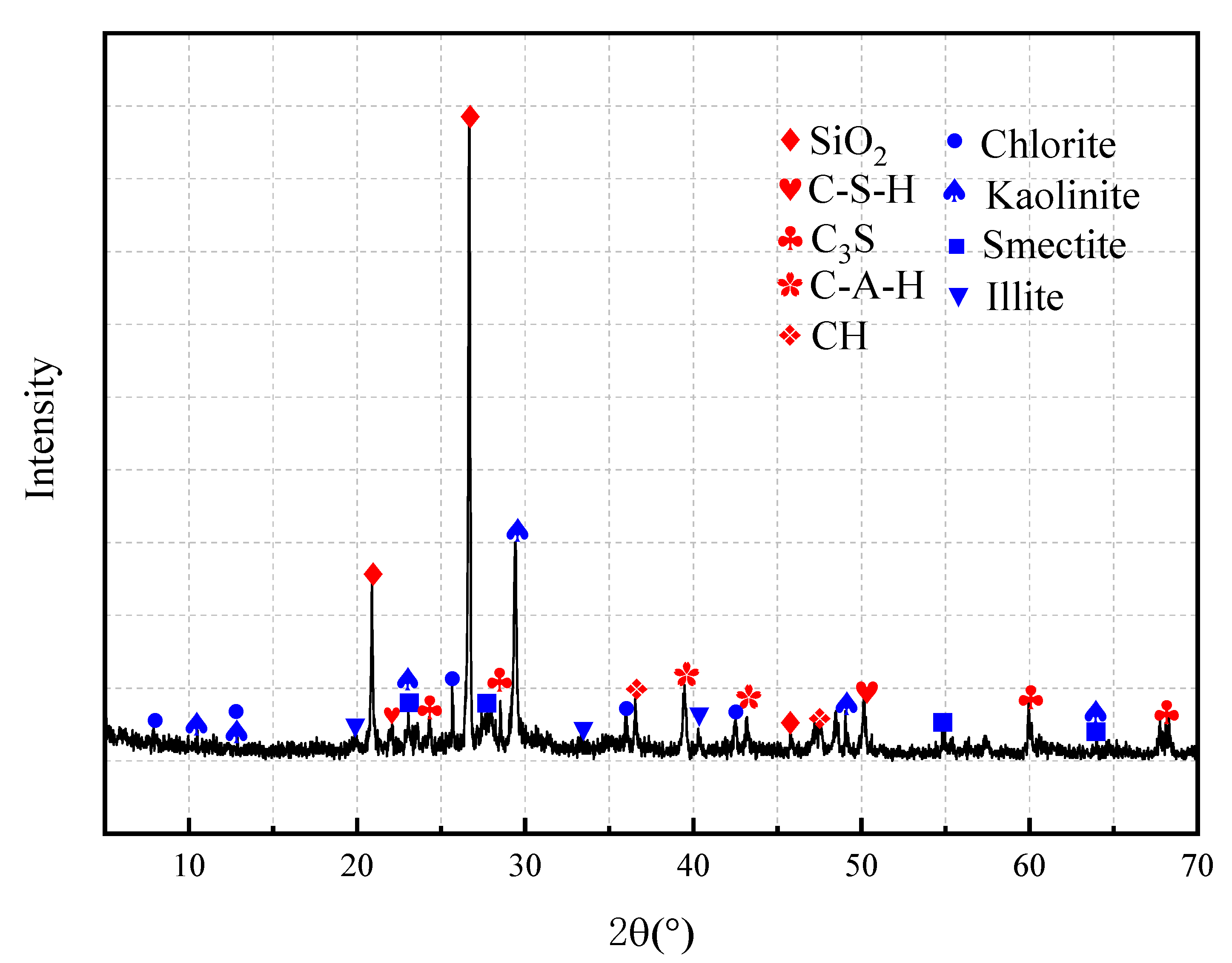
| Water Content/% | Average Specific Gravity | Natural Density /(g/cm3) | Porosity | Plastic Limit/% | liquid Limit/% | Cohesion/(KPa) | Internal Friction Angle/(°) | Impurity/(%) |
|---|---|---|---|---|---|---|---|---|
| 10.29 | 2.65 | 1.30 | 2.24 | 27.3 | 56.4 | 15 | 16 | 9.54 |
| SiO2 | Al2O3 | Fe2O3 | K2O | CaO | MgO | Miscellaneous |
|---|---|---|---|---|---|---|
| 47.21% | 32.46% | 3.05% | 1.28% | 2.35% | 1.14% | 12.51% |
| Fineness/% | Water Consumption for Standard Consistency/% | Reliability | Setting Times/ (min) | Flexural Strength/(KPa) | Compressive Strength/(MPa) | |||
|---|---|---|---|---|---|---|---|---|
| Initial | Final | 3 d | 28 d | 3 d | 28 d | |||
| 4.1 | 31% | qualified | 124 | 184 | 6.1 | 8.6 | 34.5 | 55.9 |
| CaO | SiO2 | Fe2O3 | Al2O3 | TiO2 | MgO | SO3 | Na2O | K2O | Ignition Loss |
|---|---|---|---|---|---|---|---|---|---|
| 56.78% | 23.15% | 3.89% | 7.41% | 0.24% | 1.98% | 2.45% | 0.25% | 0.26% | 3.54% |
| Independent Variable | Variable Level | ||
|---|---|---|---|
| Low (−1) | Middle (0) | High (+1) | |
| Cement content (%) | 25 | 38 | 50 |
| Sand content (%) | 0 | 7 | 15 |
| W/C | 0.4 | 0.5 | 0.6 |
| Number | Cement Content/% | Sand Content/% | W/C | Number | Cement Content/% | Sand Content/% | W/C |
|---|---|---|---|---|---|---|---|
| 1 | 25 | 7 | 0.4 | 10 | 25 | 7 | 0.6 |
| 2 | 25 | 0 | 0.5 | 11 | 38 | 0 | 0.4 |
| 3 | 38 | 15 | 0.4 | 12 | 38 | 7 | 0.5 |
| 4 | 50 | 15 | 0.5 | 13 | 50 | 7 | 0.4 |
| 5 | 38 | 0 | 0.6 | 14 | 25 | 15 | 0.5 |
| 6 | 38 | 7 | 0.5 | 15 | 38 | 7 | 0.5 |
| 7 | 38 | 7 | 0.5 | 16 | 38 | 15 | 0.6 |
| 8 | 50 | 0 | 0.5 | 17 | 38 | 7 | 0.5 |
| 9 | 50 | 7 | 0.6 |
| Number | Viscosity /(mPa·s) | Setting Time/(min) | Compressive Strength/(MPa) | Bleeding Rate /% | |||
|---|---|---|---|---|---|---|---|
| Initial | Final | 3 days | 7 days | 28 days | |||
| 1 | 390 | 130 | 260 | 0.75 | 1.61 | 2.31 | 2.1 |
| 2 | 230 | 275 | 375 | 0.63 | 1.33 | 1.82 | 5.1 |
| 3 | 440 | 125 | 245 | 1.21 | 3.24 | 4.26 | 1.4 |
| 4 | 280 | 305 | 455 | 1.55 | 3.56 | 4.51 | 3.5 |
| 5 | 120 | 325 | 505 | 1.47 | 3.17 | 3.68 | 10.3 |
| 6 | 230 | 280 | 445 | 1.13 | 3.48 | 4.86 | 4.3 |
| 7 | 240 | 290 | 450 | 1.35 | 3.66 | 5.02 | 4.2 |
| 8 | 270 | 270 | 425 | 2.14 | 5.22 | 6.13 | 3.1 |
| 9 | 140 | 330 | 535 | 3.37 | 5.74 | 6.87 | 9.5 |
| 10 | 180 | 375 | 555 | 0.69 | 1.97 | 2.46 | 9.8 |
| 11 | 360 | 150 | 255 | 1.86 | 3.93 | 5.41 | 1.6 |
| 12 | 260 | 275 | 425 | 1.46 | 3.87 | 4.97 | 4.1 |
| 13 | 380 | 135 | 265 | 2.01 | 7.71 | 8.45 | 1.1 |
| 14 | 330 | 290 | 400 | 0.88 | 2.12 | 3.24 | 4.8 |
| 15 | 220 | 250 | 435 | 1.26 | 3.62 | 4.68 | 4.6 |
| 16 | 240 | 295 | 525 | 1.42 | 3.43 | 4.14 | 8.6 |
| 17 | 220 | 260 | 415 | 1.14 | 3.68 | 5.13 | 4.3 |
| Index | Eigenvector Values | |
|---|---|---|
| First Principal Component | Second Principal Component | |
| Initial setting time | 0.978 | 0.100 |
| Bleeding rate | 0.944 | 0.058 |
| Final setting time | 0.943 | 0.170 |
| Viscosity | −0.922 | −0.206 |
| Compressive strength (3 d) | −0199 | 0.969 |
| Compressive strength (7 d) | 0.023 | 0.926 |
| Compressive strength (28 d) | −0.379 | 0.877 |
| Group | First Principal Component Score | Second Principal Component Score | Comprehensive Score | Standardized Comprehensive Score |
|---|---|---|---|---|
| 1 | −1.11938 | −1.54969 | −1.18941 | 0 |
| 2 | 0.29447 | −1.48413 | −0.40306 | −0.70929 |
| 3 | −1.60096 | −0.61966 | −1.09684 | −0.40549 |
| 4 | 0.08313 | 0.06118 | 0.06793 | −0.97489 |
| 5 | 1.45919 | 0.00512 | 0.787901 | 0.29128 |
| 6 | 0.18470 | −0.07001 | 0.07299 | 0.026984 |
| 7 | 0.14769 | 0.11452 | 0.12289 | 0.045432 |
| 8 | −0.24972 | 1.04569 | 0.261235 | 0.096576 |
| 9 | 1.23223 | 2.25084 | 1.515546 | 0.560285 |
| 10 | 1.65978 | −0.91817 | 0.546526 | 0.202046 |
| 11 | −1.34704 | 0.20555 | −0.64777 | −0.23947 |
| 12 | −0.01060 | 0.16799 | 0.057866 | 0.021393 |
| 13 | −1.73359 | 1.73861 | −0.27579 | −0.10196 |
| 14 | 0.00320 | −0.94535 | −0.35604 | −0.13163 |
| 15 | 0.12886 | −0.01599 | 0.063356 | 0.023422 |
| 16 | 0.85603 | 0.00345 | 0.462389 | 0.170941 |
| 17 | 0.01202 | 0.01006 | 0.010282 | 0.003801 |
| Source | Sum of Squares | df | Mean Square | F Value | p-Value Prob > F |
|---|---|---|---|---|---|
| Model | 2.09 | 9 | 0.23 | 66.47 | <0.0001 |
| A | 0.058 | 1 | 0.058 | 16.67 | 0.0047 |
| B | 0.0094 | 1 | 0.0094 | 2.69 | 0.1447 |
| C | 0.47 | 1 | 0.47 | 135.4 | <0.001 |
| AB | 0.68 | 1 | 0.68 | 194.92 | <0.001 |
| AC | 0.053 | 1 | 0.053 | 15.18 | 0.0059 |
| BC | 0.00052 | 1 | 0.00052 | 0.15 | 0.7104 |
| A2 | 0.062 | 1 | 0.062 | 17.85 | 0.0039 |
| B2 | 0.47 | 1 | 0.47 | 0.15 | <0.0001 |
| C2 | 0.29 | 1 | 0.29 | 17.85 | <0.0001 |
| Residual | 0.024 | 7 | 0.003488 | 133.37 | |
| Lack of Fit | 0.024 | 3 | 0.007845 | 83.18 | 0.0024 |
| Pure Error | 0.0008892 | 4 | 0.0002208 | ||
| Cor Total | 2.11 | 16 | 35.53 | ||
| Notice: R2 = 0.9884 | |||||
Publisher’s Note: MDPI stays neutral with regard to jurisdictional claims in published maps and institutional affiliations. |
© 2021 by the authors. Licensee MDPI, Basel, Switzerland. This article is an open access article distributed under the terms and conditions of the Creative Commons Attribution (CC BY) license (https://creativecommons.org/licenses/by/4.0/).
Share and Cite
Liu, W.; Qin, Y.; Meng, X.; Pang, L.; Han, M.; Song, Z. Basic Experimental Study of Plasticity Material for Coal Rock Fracture Grouting Based on RSM-PCA Technology. Energies 2021, 14, 4516. https://doi.org/10.3390/en14154516
Liu W, Qin Y, Meng X, Pang L, Han M, Song Z. Basic Experimental Study of Plasticity Material for Coal Rock Fracture Grouting Based on RSM-PCA Technology. Energies. 2021; 14(15):4516. https://doi.org/10.3390/en14154516
Chicago/Turabian StyleLiu, Weitao, Yueyun Qin, Xiangxi Meng, Lifu Pang, Mengke Han, and Zengmou Song. 2021. "Basic Experimental Study of Plasticity Material for Coal Rock Fracture Grouting Based on RSM-PCA Technology" Energies 14, no. 15: 4516. https://doi.org/10.3390/en14154516
APA StyleLiu, W., Qin, Y., Meng, X., Pang, L., Han, M., & Song, Z. (2021). Basic Experimental Study of Plasticity Material for Coal Rock Fracture Grouting Based on RSM-PCA Technology. Energies, 14(15), 4516. https://doi.org/10.3390/en14154516





